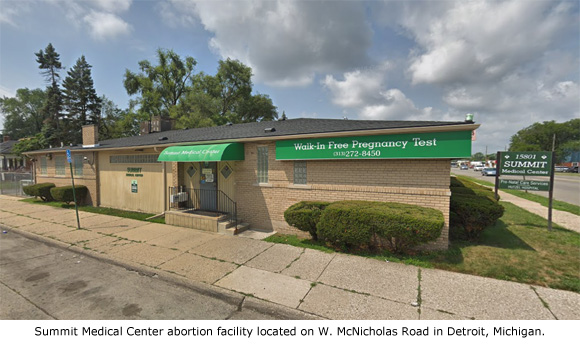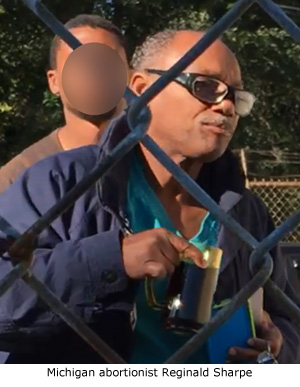
By Cheryl Sullenger
Detroit, MI – An ambulance was called on May 11, 2019, to the Summit Medical Center in Detroit for a 17-year old teen who was having breathing difficulties.
According to a 911 document received by Operation Rescue, the girl was not completely alert and was “not responding appropriately.”
The girl had a history of asthma, but did not have a prescribed inhaler with her. Once the ambulance arrived and she was treated by EMS, she appeared to recover and the ambulance was cleared within five minutes of arrival.
It does not appear that the teenager was transported to the hospital.
“If it was just a matter of needing a rescue inhaler, why didn’t the abortion clinic maintain a backup inhaler or check to make sure she brought one with her?” asked Troy Newman, President of Operation Rescue. “We are glad this girl recovered quickly, but it seems like this was a completely avoidable situation if the clinic staff was properly trained and equipped to handle this most basic of incidents.”
Summit Medical Center is a designated “Green Light” business. This means it is given special priority through the Project Green Light system, a controversial program that allows businesses to pay $4,000-6,000 to join. This covers the cost of installation of high-definition cameras and extra lighting. Businesses also pay $150 per month in fees for cloud-based storage. These businesses are then given preferential treatment when it comes to delegating emergency assets.
Then on May 16, 2019, a call was placed to 911 from Summit Medical Center at 24 minutes after midnight. The call was for someone experiencing abdominal pain. A unit was dispatched to the abortion clinic’s address.
Four minutes later, the call was cancelled. It was supposedly “made by mistake.”
However, the call in the middle of the night raises questions. Why was this abortion clinic occupied at that hour and who was suffering from abdominal pain there that prompted the call in the first place?
“Sometimes when women have abortion complications, they are told to go back to the abortion clinic instead of the emergency room, even in the middle of the night, as we have seen before in other places,” said Newman. “We don’t know if that was the case here, but it makes sense.”
While these medical emergencies were not the most serious of cases, they do illustrate that things go wrong at abortion facilities more often that most people might think. The 17-year old girl and the mysterious midnight person with abdominal pain were very lucky their conditions were not worse, especially considering the abortionist who works there.

Reginald Sharpe has been disciplined several times for grossly negligent abortions – one of which resulted in a patient death. Here are a few of Sharpe’s misadventures (documentation available):
• December 1998: Sharpe was fined $2,500 and placed on probation for a year for “improperly delegating the administration of schedule IV controlled substances.” • June 2005: A Consent order was issued fining Sharpe $5,000 and suspending his license for 120 days followed by one year of probation with other requirements. Sharpe had “left a patient unattended in recovery, in pain, and without medical attention for several hours after he could not successfully complete her abortion.” • January 11, 2008: Sharpe conducted an abortion on a 26-year old African-American Detroit woman listed as “Patient 1” who was 15 weeks, 2 days pregnant. When she began to seize during the abortion, he halted the procedure. Sharpe had perforated her uterus and caused internal hemorrhaging. It wasn’t until she went into respiratory arrest that his staff called 911. Patient 1 suffered cardiac arrest on the way to the hospital and was pronounced dead on January 19, 2008. Her cause of death was listed as “uterine perforation and complications.” • August 5, 2011: Sharpe conducted a disastrous abortion on “Patient 2.” Her pre-born baby was 19 weeks gestation. No IV was administered and her cervix was not properly prepared for the risky procedure. Sharpe perforated her uterus and shoved her baby’s head outside her uterus into her abdominal cavity and left other body parts in her uterus. She suffered post-operative internal hemorrhage as a result and was forced to undergo a hysterectomy to save her life. • February 27-28, 2014: Sharpe conducted a two-day 23-week abortion on “Patient 3.” He again perforated his patient’s uterus and caused internal hemorrhaging. Sharpe was found to have failed to provide appropriate monitoring for Patient 3 and failed to record vital signs. An ambulance transported her to Botsford Hospital in Farmington Hills, Michigan, where doctors conducted surgery to “repair the perforation and remove the retained fetal cranium and tissue from the patient’s abdominal cavity.” • June 16-17, 2014: “Patient 4” went to Sharpe for a two-day late-term abortion on her 22-23-week old pre-born baby using a “D&C” procedure “without a nurse or other medical professional present while the patient was sedated.” He failed to properly note dosages in Patient 4’s medical records. • December 31, 2014: Sharpe began a dilation and evacuation procedure on “Patient 5” and her 16-week baby. He halted the procedure when he realized she was not sufficiently dilated. An hour and a half later, he tried to resume the abortion, but her membranes had spontaneously ruptured. She was transferred to Detroit Medical Center’s Sinai-Grace Hospital “For the completion of the abortion procedure and additional care.” Sharpe failed to properly document the procedure, information about drugs used, and did not document the location of the placenta even though the patient had a previous Cesarean delivery.
“This is yet another abortion facility where we are warning women to beware. The dangers here cannot be overstated,” said Newman. “It should be closed for the good of humanity and in the interest of public safety.”




Leave a Reply